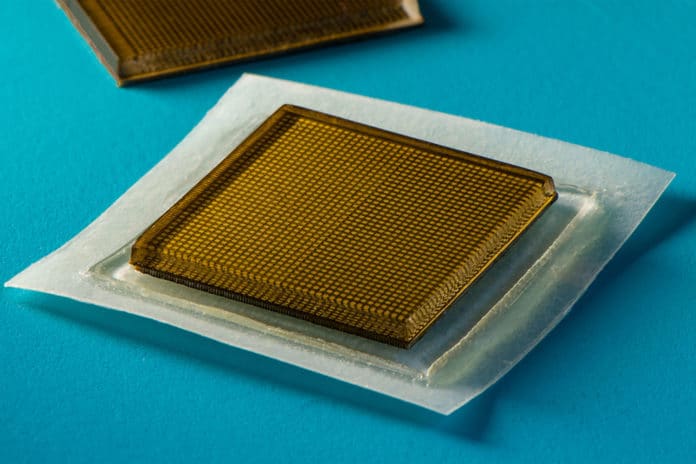Ultrasound is widely used for the noninvasive imaging of tissues and organs. However, this method requires close contact between the transducer and the target area. Plus, ultrasound imaging requires bulky and specialized equipment. But a new design by MIT engineers might make the technology wearable and accessible.
Scientists have developed a wearable ultrasound imaging device– a new ultrasound sticker- that sticks to the skin and can offer continuous ultrasound imaging of internal organs for 48 hours. This bioadhesive ultrasound (BAUS) device consists of a thin and rigid ultrasound probe robustly adhered to the skin via a couplant made of a soft, tough, antidehydrating, and bioadhesive hydrogel-elastomer hybrid.
Scientists applied the stickers to volunteers and showed the devices provide 48 hours of continuous imaging of diverse internal organs, including blood vessels, muscle, heart, gastrointestinal tract, diaphragm, and lung. At the same time, it maintained a strong adhesion and captured changes in underlying organs as volunteers performed various activities, including sitting, standing, jogging, and biking.
Ultrasound imaging requires applying a gel onto a patient’s skin, which acts to transmit ultrasound waves. A probe, or transducer, is then pressed against the gel, sending sound waves into the body that echo off internal structures and back to the probe, where the echoed signals are translated into visual images.
Stretchable ultrasonic probe designs have been studied recently to enable portable and low-profile internal organ imaging. These designs provided a flexible array of tiny ultrasonic transducers with the idea that they would adapt to the shape of a patient’s body.
But because of their stretch, these experimental designs have created low-resolution images: Transducers move relative to one another as the body does, causing image distortion.
The newly designed ultrasound sticker provides high-resolution images over a longer duration by pairing a stretchy adhesive layer with a rigid array of transducers. Because of this combination, the device can stick to the skin and simultaneously maintain the relative location of transducers to generate clearer and more precise images.
The sticky layer of the device is constructed from two thin layers of elastomer that enclose a middle layer of solid hydrogel, a substance that is primarily water-based and effectively transmits sound waves.
Xiaoyu Chen, an MIT postdoc, said, “The elastomer prevents dehydration of hydrogel. Only when the hydrogel is highly hydrated can acoustic waves penetrate effectively and give high-resolution imaging of internal organs.”
The bottom elastomer layer is designed to stick to the skin, while the top layer adheres to a rigid array of transducers that the team also designed and fabricated. The entire ultrasound sticker measures about 2 square centimeters across and 3 millimeters thick — about the area of a postage stamp.
When scientists put the stickers on a test, they found that they stayed attached to their skin and produced clear images of underlying structures for up to 48 hours. Based on the sticker’s images, the team could observe the changing diameter of major blood vessels when seated versus standing.
Scientists also captured details of deeper organs, such as how the heart changes shape as it exerts during exercise. They were also able to watch the stomach distend, shrink back as volunteers drank, and later passed juice out of their system. And as some volunteers lifted weights, the team could detect bright patterns in underlying muscles, signaling temporary microdamage.
Chen said, “With imaging, we might be able to capture the moment in a workout before overuse and stop before muscles become sore. We do not know when that moment might be yet, but now we can provide imaging data that experts can interpret.”
The team is working to make the stickers function wirelessly. They are also developing software algorithms based on artificial intelligence to interpret better and diagnose the stickers’ images.
Tao Zhao at MIT said, “We imagine we could have a box of stickers, each designed to image a different location of the body. We believe this represents a breakthrough in wearable devices and medical imaging.”
Journal Reference:
- Chonghe Wang, Xioyu Chen, et al. Bioadhesive ultrasound for long-term continuous imaging of diverse organs. Science. 28 Jul 2022. Vol 377, Issue 6605. DOI: 10.1126/science.abo254
